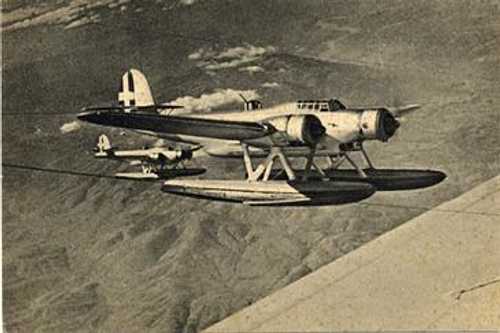
Italian Forces
Seaplanes over the Epirus: a few know story
Stato Maggiore Aeronautica
Italian maritime bombers Cant-Z-506 Airone (Heron) in flight over the mountains: an unusually landscape for an aircraft born for the sea. In reality this floatplanes flying in front to Epirus mountainous coast during a few knew phase (December 1940-April 1941) of the Greco-Italian War: the harassment operations of the Greek coastal navigation committed, with little tonnage merchant fleet, about twenty small vessels, mainly motor sailer, trawler e little steamship, to provide the troops deployed along the Ionian coasts in the Epirus region, an impracticable area with few reasonable roads. Because the distance of this region from the Albanian base of the Italian Navy’s torpedo armed motorboat (MAS), the Italian Air Force made available to Regia Marina (Italian Navy) the 86th Gruppo of the 35th Stormo Bombardamento Marittino (Maritime Bombardment) based at Brindisi and equipped with 18 floatplanes Cant-Z-506 (serviceable 50%) for armed reconnaissance missions accomplished by a two aircraft section each armed with sixteen 20 kg bombs or twelve 50 kg bombs. Target: maritime traffic or, as an alternative, harbors. The first mission was accomplished on 20 December 1940 hitting a steamship off Preveza. During the afternoon of same day about 15 motor sailer was attacked and two claimed as sunk. On 24 December a steamship was bombed off Corfu. This missions forced the Greek to night navigation while the No 30 Squadron RAF deployed at Athens with Bristol Blenheim IF Greece started some patrols over the Peloponnese coast. On 30 December 1940 the first air clash: a section of two Italian seaplanes was attacked by two No 30 Squadron’s Blenheim IF which downed a Cant-Z-506, crew rescued in the sea by the Greeks, while one British aircraft was damaged by the fire of the other seaplane. Another clash with the RAF occurred, but without result, on 5 January 1941 between an Airone and a Blenheim while on 12 January a Cant-Z-506 during a fight at very low altitude above the sea along the West Greek coast attacked and damaged a large British seaplane Short Sunderland. On 2 February another clash between a Sunderland and a Cant-Z-506: the latter damaged and obliged to head to Benghazi. Another “506” was lost on 24 February for troubles near the Antipaxos Island. A clash with the Greek fighters occurred on 22 March when a Hellenic Air Force’s Gloster Gladiator attacked a Cant-Z-506. The Italian crew claimed the shooting down of the Gladiator, loss not confirmed by the Greeks. In the meantime, 8 February, the Italian seaplanes bombed Pylos but, because the adverse meteorological conditions which characterized the entire Greek Campaign with few flyable days, the activities of the Italian seaplanes along the Ionian coasts was very scarce and in meantime the 86th Gruppo’s strength was reduced to a dozen of Cant-Z-506, 50% serviceable). On 29 March Pylos was again attacked: bombed a steamship 5,000 gross tons without result, but a motor sailer sunk and another strafed and burned. On April 1941 the Cant-Z-506 of the 86th Gruppo accomplished reconnaissance over the Piraeus harbor and Volos. But in the same the chief of staff Italian Air Force, General Francesco Pricolo, stopped this type of missions in favor of the Navy, never approved by the Air Staff, and ordered raids over land targets and escort to land bombers flying over the sea. Ironically the great target, the most of the Greek merchant ships in the Peloponnese (the Morea of the ancient Venetians), was detected at the end of the Campaign when, on 22 April 1941, two Cant-Z-506 discovered and raided in Paxos harbor about twenty trawlers embarking troops retreating from the Epirus hitting at least two of them. The Greek sources admitted the loss in the Peloponnese’s sector of 18 small merchant ship but this total include, a part the torpedo boat Proussa sunk by the Italian Stukas on 4 April 1941, the steamship Susanna (882 tons) dive bombed and sunk on the same 4 April by Ju 87s of the Italian Air Force’s 239th Squadriglia. For the Maritime Bombardment was the swan song: on June 1941 the Gruppi Bombardamento Marittimo (BM) was disbanded and transformed in unit of Maritime Reconnaissance (Ricognizione Marittina-RM) armed only with anti-submarine bombs. Last note: the aircrafts of the photo have an all-silver finish with the with cross over a black rudder. This pre-war livery (not visible in the photo the red strips upper the wing) was kept by the BM Groups until their disbandment. When this units was converted to Maritime Reconnaissance, for the Cant-Z-506 was adopted a complete dark grey-blue finish. Victor Sierra
3628 Views
3/21/2013
